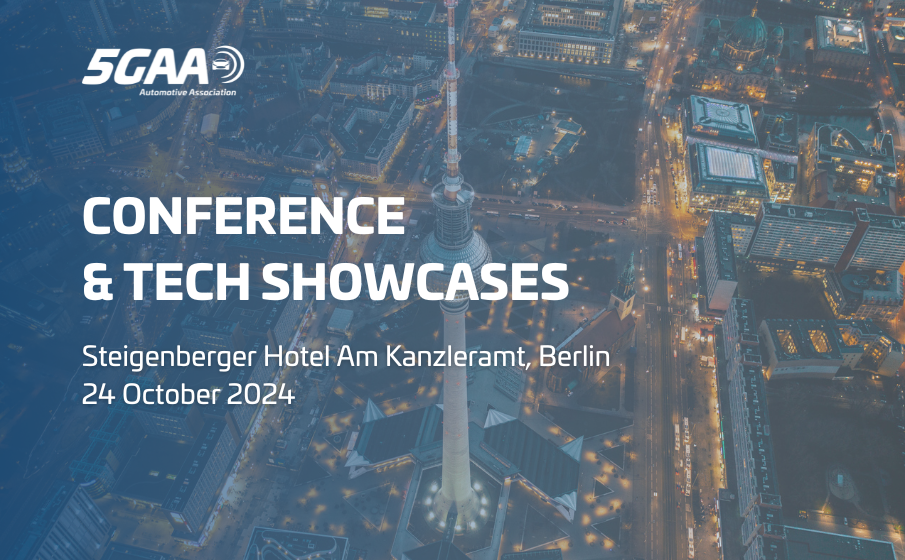
5GAA Conference and C-V2X Showcases in Berlin
The 5G Automotive Association (5GAA) will be hosting a conference and C-V2X technology demonstrations on 24 October in Berlin, Germany.
The conference , ‘Scaling up connected mobility: What’s next for Germany and Europe?’ will discuss the latest developments in connected mobility policy and technology. Find the agenda here.
The 5G Automotive Association (5GAA) will host a technology demonstration event in Berlin on 24 October, showcasing the potential of Cellular Vehicle-to-Everything (C-V2X) technology to redefine mobility across Europe. The event will take place with 5GAA members, leaders from the automotive, telecommunications and technology sectors; it will feature over 10 indoor and outdoor demonstrations that address both critical safety and advanced applications. Download the brochure here
Both events will take place on 24 October at the Steigenberger Hotel am Kanzleramt in Berlin. For more information and registration, you can contact liaison@5gaa.org.

Meet Our Members – Interview with Menno Malta, Monotch CEO
The 5G Automotive Association (5GAA) thrives on the collective expertise and collaborative spirit of its members. Over 110 organisations strong, our membership represents a global network of market leaders and innovators shaping the future of connected mobility.
We are kicking off a new series, “Meet Our Members,” to delve deeper into the stories of the individuals who make up the backbone of 5GAA. First up, we will be featuring Menno Malta, CEO of Monotch, who has been actively involved in one of 5GAA’s most recent and exciting areas of work – Vehicle-to-Network-to-Everything (V2N2X) communication.
This interview series will showcase a diverse range of profiles, highlighting their contributions, challenges, and predictions for the exciting world of 5G-connected transportation. Get ready to be inspired by the passion and ingenuity of our members as we meet the people who make 5GAA.
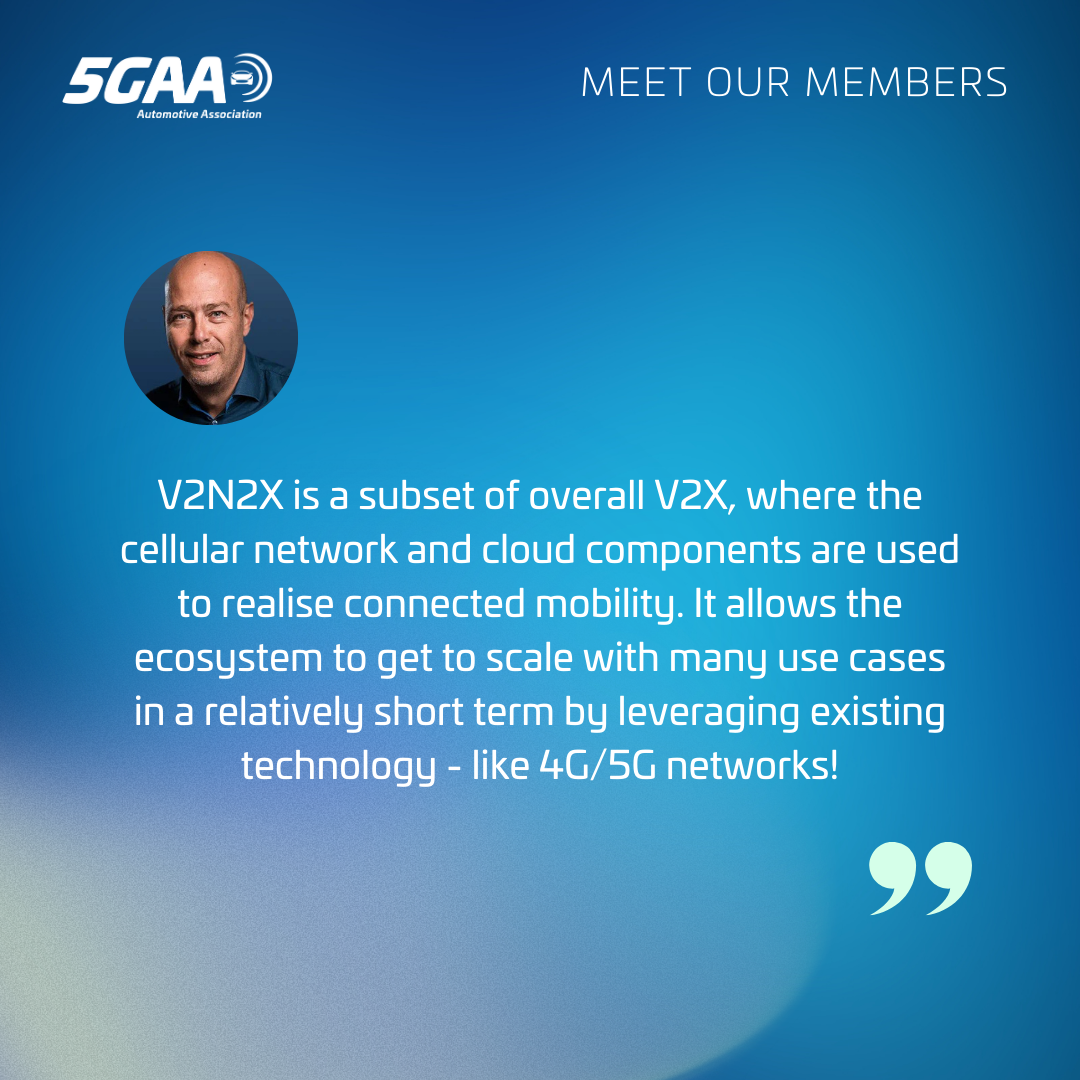
Menno, you are the CEO of Monotch, a 5GAA member company. How does Monotch’s work relate to 5GAA’s, and what keeps you engaged with our association?
Monotch operates at the forefront of the V2N2X market. Our proven TLEX platform is used by cities and road authorities all over the world to connect mobility and digital infrastructure bringing substantial societal benefits and increased cost-effectiveness.
The initial interest that drew us to 5GAA was the opportunity to engage with OEMs, mobile network operators, and related industries. This is still of interest! We really appreciate the possibilities to discuss developments and work jointly on progressing the market. The networking opportunities are also great for us.
Monotch is based in the Netherlands. Last year, your views were instrumental in the organisation of 5GAA’s workshop in the Hague, where we looked at C-V2X deployment in the Low Countries. Two years later, what is the state of play for C-V2X and connected mobility in the Netherlands, and how do you see it unfolding?
In the Netherlands, we see a steady growth of smart and connected roadside infrastructure as well as new use cases such as emergency vehicle warnings that are now available on a large scale. This leads to more connected parties, including the first vehicle OEMs. On top of this, there is a push on urban challenges and use cases, which will lead to even more data and impact in the next few years. The Netherlands is truly a lighthouse deployment, and authorities from other countries come here often to see what’s happening and how they can apply learnings in their own jurisdiction.
One of 5GAA’s recent areas of work has been vehicle-to-network-to-everything (V2N2X) communications, and you’ve been one of its main contributors. What is V2N2X, what makes this such an important topic, and what are some of the biggest hurdles to overcome in achieving its widespread adoption?
V2N2X is a subset of overall V2X, where the cellular network and cloud components are used to realise connected mobility. It allows the ecosystem to get to scale with many use cases in a relatively short term, as it leverages existing technology such as apps, onboard units and, of course, the 4G/5G network! I think it’s hugely important for 5GAA as it shows the value of a connected ecosystem to the main stakeholders and can kickstart overall C-V2X deployment.
The V2N2X work item has been concluded with the publication of a white paper, ‘Road Traffic Operation in a Digital Age,’ and two associated reports. What is the objective of these publications, and how do they complement each other?
The white paper can be seen as a summary of the Technical V2N2X Architecture report. It’s a great read for everyone involved in this market, whether you’re an authority or a private sector executive. The Technical V2N2X Architecture report offers detailed insights into the blueprint architecture, and I recommend it to subject matter experts.
The other technical report is of a different nature. It describes the V2N2X market from a business perspective—for example, the market size, the kinds of business models we see, and which factors drive the market. It also contains descriptions of large-scale example deployments, taking away whatever doubts people might have about the feasibility of V2N2X..
The upcoming online session on 18 June will present the findings of these publications. What are you most excited about sharing with the audience?
So much to share! I can promise the session will be packed with insights, but I’m probably most excited to share the OEM and IOO (Infrastructure Owner and Operator) customer profiles we created. It’s about their goals, pains and gains, and for this, we did a survey and an analysis of large-scale deployments. I’m so excited about it because it really ties to the why of our work.

ADAS and Autonomous Vehicle Technology Expo: 5G Automotive Connectivity – What to Expect and When
5GAA Chief Technology Officer Maxime Flament is in Stuttgart today to present on ‘5G Automotive Connectivity: What to expect and when’ at this year’s ADAS and Autonomous Vehicle Technology Expo.
Taking place from 09:25-9:50, Maxime gave attendees an overview of the 5GAA roadmap ramping up toward increasingly advanced use cases in the 2030 timeframe, while also touching on the importance of the full integration of V2X technology into ADAS and automated driving systems (ADS).
Find the 5GAA 2030 Roadmap here.
Among other things, Maxime explained to attendees how:
- Many safety and traffic V2X use cases are emerging, from simple hazard warnings to teleoperation gradually increasing levels of complexity and automation
- The 5GAA roadmap envisions a rapid integration of V2X into ADAS and ADS
- Automotive connectivity exploits different radio access: vehicle-to-network, vehicle-to-vehicle, vehicle-to-roadside and vehicle-to-satellite
- Recent progress has been demonstrated in accurate positioning, low-latency services using MEC, 5G-compliant satcom, pedestrian and cyclist protection, etc
- Auto manufacturers are focussing on 5G 3GPP standards
Maxime also had the chance to meet with 5GAA members exhibiting their innovative 5G-V2X solutions at the event.
The ADAS and Autonomous Vehicle Technology Expo is one of the world’s biggest conferences focused on ADAS and assisted driving and is not to be missed for anyone with an interest in connectivity and connected mobility.
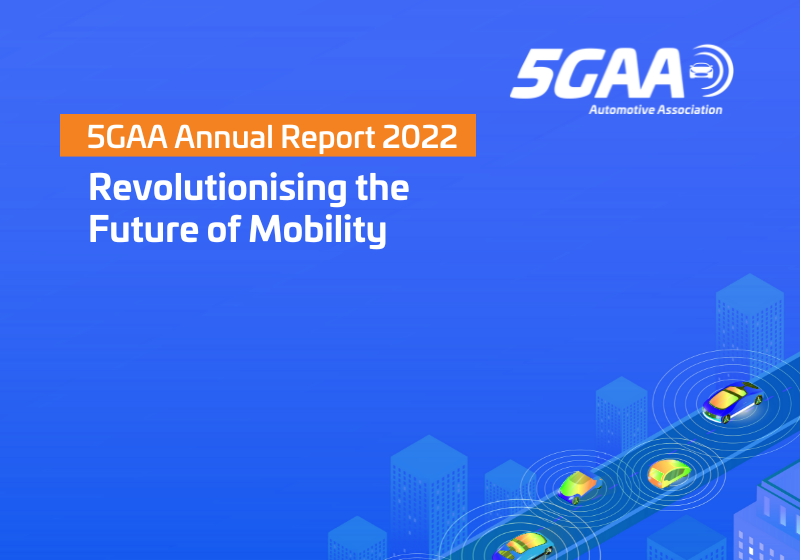
Revolutionising the Future of Mobility: 5GAA Unveils Annual Report
This comprehensive document highlights the remarkable progress and achievements made by 5GAA throughout the year, shedding light on the groundbreaking solutions and advancements shaping the future of mobility and transportation.
With a remarkable membership base comprising over 120 influential players, including major automotive manufacturers, Tier-1 suppliers, communication system providers, mobile operators, and infrastructure vendors, 5GAA has become a driving force behind developing end-to-end solutions for future mobility.
Since our inception in September 2016, we have rapidly expanded, attracting 13 of the top 15 global automakers, major telecommunications companies, and the world’s leading wireless infrastructure providers.
The annual report showcases the relentless dedication of 5GAA in supporting the establishment of cellular vehicle-to-everything (C-V2X) technology in the market. By fostering cross-industry alignment and collaboration, 5GAA has paved the way for revolutionary advancements in connected and automated driving.
The report provides valuable insights into the progress made in deploying LTE-V2X technology while positioning 5G-V2X as the next phase of the C-V2X evolution.
Through our 2030 visionary roadmap, we have outlined our strategic plans for the future, setting a clear direction for the global introduction of advanced use cases for connected and automated driving. The roadmap, regularly updated to reflect the latest industry developments, serves as a vital instrument to align the efforts of automakers, network operators, and equipment providers globally. It presents a consolidated view of the transformative potential of 5G-V2X technology and its impact on improving road safety, enhancing traffic efficiency, and reducing emissions.
Furthermore, the annual report emphasises the pivotal role of international dialogue and collaboration within the ecosystem. By facilitating regular meetings between 5GAA members and road operators, the organisation fosters the exchange of views, experiences, and best practices related to 5G technology and the infrastructure required to build a truly connected ecosystem.
As the world witnesses the growing number of network-connected vehicles and the integration of LTE-V2X direct communications, the annual report underscores the critical importance of leveraging existing developments and paving the way for 5G-V2X.
This future-ready technology represents the next frontier of direct automotive connectivity and catalyses the widespread adoption of automated driving.
With our commitment to innovation, collaboration, and shaping the future of mobility, 5GAA’s annual report sets the stage for an exciting future. By pushing boundaries and revolutionising the automotive industry, we continue to redefine what is possible in connected and automated driving.
Read our annual report here, and delve deeper into the association`s achievements.
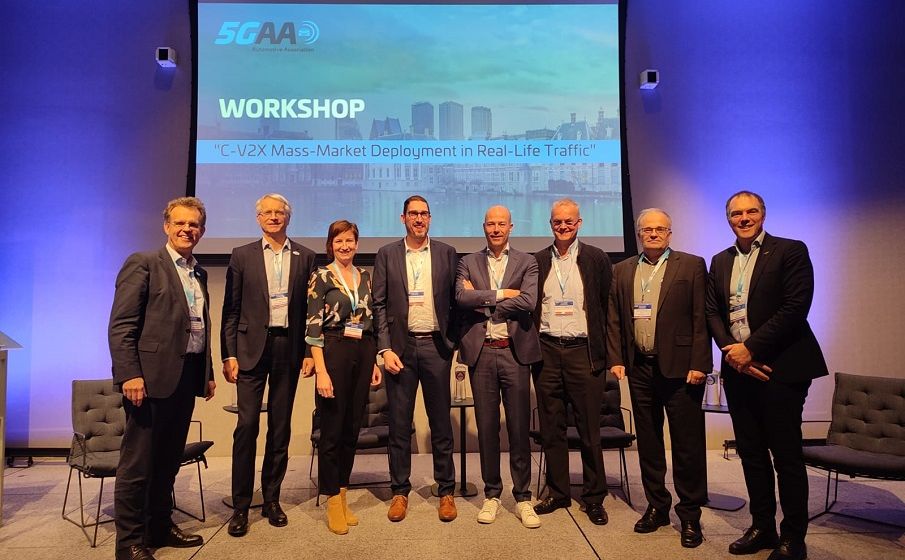
5GAA and partners discuss C-V2X mass-market deployment in The Hague
On February 9, to conclude its first meeting week of 2023, the 5G Automotive Association held a workshop on “C-V2X Mass Market Deployment in Real-Life Traffic”. Over two sessions, speakers examined connected mobility for road management in The Netherlands and Flanders and the benefits of connected mobility services for end-users.
Continuing a tradition established last year in Atlanta (US) and Málaga (Spain), the 5G Automotive Association capped off its meeting week in The Hague —the first of four to be held in 2023 — with a workshop for members and guests.
The workshop, which took place on the morning of February 9 at the Marriott Hotel in the Dutch capital, gathered delegates and partners for two different sessions featuring representatives from member organisations, public stakeholders, and road operators. 5GAA Director General Johannes Springer was responsible for welcoming attendees, while Vice Chair Uwe Puetzschler delivered the closing speech with an outlook of what is coming for 5G-V2X.
During the first session, participants got an overview of the Netherlands’ and Flanders’ Connected Mobility Roadmaps from Wim Vandenberghe, Senior Advisor for ITS and CCAM at the Dutch Ministry of Infrastructure and Water Management, and Erika Decorte, Program Manager at the Flanders Authority for Roads and Traffic. Menno Malta, CEO of Monotch, wrapped up the session by delving into the C-ITS ecosystem deployment and architecture.
The second session, on the other hand, explored how end-users are leveraging connecting mobility services. René Spaan, Project Leader for Smart Mobility in the City of Helmond (Netherlands, presented use cases in urban settings. Participants also got to learn more about C-V2X services for emergency vehicles thanks to Gerard Berendschot, Manager of Quality and Policy at the Netherlands’ Ambulance Care. Finally, 5GAA delegate Andreas Schaller, Head of V2X Technology at Bosch, introduced the audience to the wrong-way driving application.
After the workshop, the 5GAA Board hosted a close-door roundtable with nine road operators, who received a presentation about the association’s new C-V2X roadmap and engaged in some interactive discussions to dive into their priorities, needs, and expectations. This roundtable followed on 5GAA’s recent release of its “Conclusions and Recommendations for Communications Service Providers Supporting Road Operator Priorities and Expectations”, available here, and a technical report on “Road Operator Use Case Modelling and Analysis.”
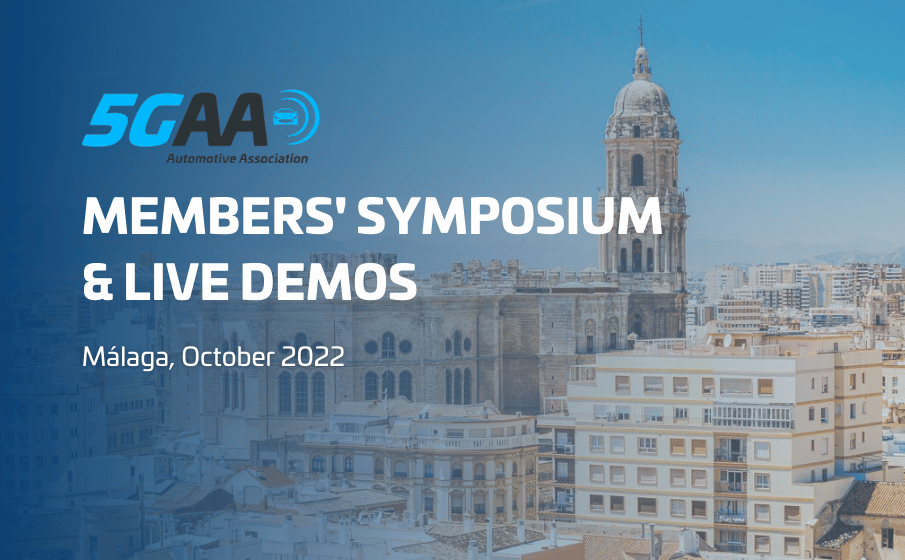
5GAA in Málaga: Symposium & Live Demos
In October 2022, sixteen members of the 5G Automotive Association gathered at the DEKRA facilities in Málaga to showcase ready-to-deploy C-V2X technology and what the future has in store for connected and automated mobility. Prominent members and partners of the 5GAA including 5GCroCo, Anritsu, Autotalks, Commsignia, Continental, Deutsche Telekom, Ericsson, Huawei, Intel, Keysight, Molex, Nokia, Rohde & Schwarz, Stellantis, Vodafone and Omniair demonstrated the current state of C-V2X and a wide range of applications for VRU (Vulnerable Road Users) protection, through a range of indoor and outdoor demos. The over 200 attendees included road operators, journalists from national and international media, and 5GAA delegates.

Road Operator Use Case Modelling and Analysis
The 5GAA work item BRIDGE aims to determine how Communications Service Providers (CSPs) can support the C-ITS/V2X expectation of Road Operators in the near future to encourage and accelerate the deployment of C-ITS use cases on the road.
Following on from a series of discussions with European Road Operator strategists, a set of four exemplary C-ITS use cases was identified with a view to understanding what might be required from CSPs to achieve the above-mentioned objective. Additionally, a set of possible network requirements were defined and short-listed. Modelling showed that all of the use cases can be delivered on existing mobile networks today, assuming network coverage is sufficient for Road Operator requirements.
Find out the rest on this 5GAA Technical Report.
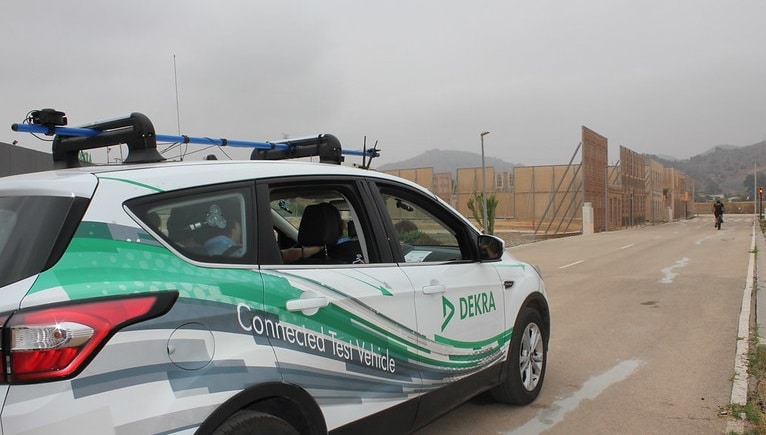
5GAA Demonstrated C-V2X Technology Applications and Safety Benefits for Road Users last October in Málaga, Spain
Malaga, 20 October 2022 – C-V2X technology revolutionizes the mobility ecosystem and how drivers interact with the world, making smart cars a reality today. These cars communicate with their surrounding infrastructure, be it other cars or vulnerable road users, while providing a better driving experience. 5GAA is at the forefront of redefining transportation, by providing real-time, reliable, and actionable information flows to enable safety, mobility, and environmental applications.
Sixteen 5GAA members gathered in Malaga on October 20 to showcase ready-to-deploy C-V2X technology and what the future has in store for the industry and vulnerable road user protection. Prominent members and partners of the 5GAA including 5GCroCo, Anritsu, Autotalks, Commsignia, Continental, Deutsche Telekom, Ericsson, Huawei, Intel, Keysight, Molex, Nokia, Rohde & Schwarz, Stellantis, Vodafone and Omniair demonstrated the current state of C-V2X and a wide range of applications for VRU (Vulnerable Road Users) protection, through a range of indoor and outdoor demos. The over 200 attendees included road operators, journalists from national and international media, and 5GAA delegates.
“C-V2X continues to drive the automotive transformation – and is now the new reality,” says 5GAA Chairman, Christoph Voigt. “Our key asset, the C-V2X technology, became an important part of the worldwide V2X ecosystem. The live demonstrations we have seen here, in Malaga, show us repeatedly that C-V2X is ready for a future where we can use our current infrastructure to improve protection for vulnerable road users.”
Using both direct and mobile network communications, the open-road demonstrations displayed the extensive capabilities of today’s C-V2X technology. To name a few:
- Protecting vulnerable road users and increasing the safety of cyclists on the road by alerting them of a collision
- Enabling smart intersections to enhance VRU safety by sending awareness messages to C-V2X-enabled cyclists
- Warning road users of traffic incidents between connected vehicles
The demonstrations were held at the DEKRA Test Track, a private field-testing area dedicated to connected & automated driving in Málaga, Spain. The test track reproduces multiple traffic situations using different V2X communications systems and networks, as well as traffic elements like traffic signs, traffic lights, road cones, pedestrians’ simulators that allow setting up various test cases. Located in a restricted area of 51.000 m2 (about twice the area of a parking space) with roundabouts, straight and curved roads, intersections, traffic lights and signalling, this connected & automated driving test track is a state-of-the-art facility that researches, develops, tests, and certifies the mobility of the future.
Together with our members, 5GAA has embraced digital transformation and is creating opportunities for transportation innovation. Its goal is to develop end-to-end solutions for future mobility that improve traffic efficiency, driving comfort and road safety to ensure a secure and sustainable transportation ecosystem.

Federal Funding Opportunity for Wireless Technology: Safe Streets and Roads for All (SS4A) Grant Program
Through September 15, 2022, a Notice of Funding Opportunity (NOFO) from the U.S. Department of Transportation (USDOT) will be open for Safe Streets and Roads for All (SS4A) grants in FY22. It’s an opportunity for companies to apply for a part of $1 billion per year in FY22-26 grants to prevent roadway deaths and serious injuries.
The timing is fortuitous. Newly released traffic crash estimates from the National Highway Traffic Safety Administration (NHTSA) show that traffic fatality rates in 2021 are the highest since 2005. NHTSA projects a final tally of 42,915 lives lost during 2021 in traffic crashes nationwide.
Making transportation safer and more equitable
To support its goals, the SS4A program funds activities that will help lower fatalities on U.S. roads and highways. The program is also an opportunity to fund regional, local and Tribal initiatives aimed at making transportation equitable for all road users.
Equity is an important element in underserved communities, which are disproportionately affected by fatalities among vulnerable road users (VRUs). These users include pedestrians, cyclists and the growing number people using micro-mobility options such as e-bikes and scooters.
Underserved communities also have higher vehicular traffic volumes, trucking routes and major arterial roads. They are characterized by intersections that are unsafe or impassable by foot or bike, and an overall lower level and quality of walking and cycling infrastructure. NHTSA’s projections for 2021 show alarming increases in fatalities for pedestrians (13 percent), motorcyclists (9 percent) and bicyclists (5 percent), making the SS4A funding opportunity even more fortuitous for VRUs.
Applying C-V2X technology to prevent road fatalities
Many roadway deaths are preventable. Cellular-vehicle-to-everything (C-V2X) is a wireless technology that allows vehicles to communicate directly with each other (V2V), with roadside infrastructure (V2I) and potentially with pedestrians (V2P). C-V2X supports information sharing to facilitate applications that enhance safety for all road users.
NHTSA believes that safety applications supported by V2V and V2I could eliminate or mitigate the severity of up to 80 percent of non-impaired crashes. Also, connected vehicle technology is on the National Transportation Safety Board’s Most Wanted List of transportation safety improvements.
The following use cases illustrate the immediate impact of safety applications that use C-V2X technology:
- Red-light violation warning (RLVW)
More than half of all fatal and injury crashes happen at intersections (source). The most common cause of all urban crashes, drivers running red lights result in an average of seven fatalities and more than 1,000 injuries per day at signalized intersections across the country (source).

- Intersection movement assist (IMA)
Similar to RLVW, IMA safety applications can alert other drivers when someone is running a red light so they can take action to stop before entering the intersection. - Spot weather warnings
Inclement weather, which can result in road hazards such as icy patches on highways, are not easily detected by LIDAR sensors. Infrastructure-to-vehicle (I2V) applications can send a warning to approaching vehicles, reducing the potential for sharp drops in speed that can result in road incidents. - Traffic signal pre-emption
Aimed at shortening emergency response times to help save lives, this use case allows vehicles like ambulances and fire trucks to remotely trigger a green light. Related V2V applications share this information with nearby vehicles so drivers can take action to move out of the way, reducing congestion along the route to improve safety for first responders and road users alike. - School zone safety
C-V2X alerts drivers when they are entering an active school zone and notifies them of the reduced speed limit. Future applications might include automatically slowing vehicles as they approach an active school zone.
See more use cases below.
What you can’t see can hurt you, and C-V2X plays a critical safety role because it allows the vehicle to see more than the driver can see. Regular sensors keep vehicles safe in immediate surroundings; C-V2X provides more robust signaling to help vehicles see around blind corners and many other types of obstructions. It connects vehicles and roadside infrastructure that are not in each other’s line of sight and allows them to share information about traffic conditions.
How C-V2X fits with SS4A
SS4A accepts both Action Plan Grants and Implementation Grants, with the latter drawing upon the foundation of the former. The program calls out four selection criteria:
- Safety impact
- Equity, engagement, collaboration
- Effective practices and strategies
- Climate and sustainability, and economic competitiveness
Two notable considerations are project readiness and funds to underserved communities.
USDOT lists several sample activities for Implementation Grants that align closely with C-V2X, including these:
- Deploying advanced transportation technologies, such as the installation of connected intersection-based safety solutions and vehicle-to-infrastructure advisory speed limit systems (e.g., intelligent speed assistance — see above)
- Evaluating and improving the safety of intersections by considering innovative design changes, improved delineation, and advanced warning
- Creating safe routes to school and public transit services through multiple activities that lead to people safely walking and biking in underserved communities.
- Promoting the adoption of innovative technologies or strategies for the safety and protection of VRUs in high-traffic areas where commercial motor vehicles (CMVs), pedestrians, bicyclists, and motorcyclists interact.
Next steps
As part of the Bipartisan Infrastructure Law, SS4A is a discretionary program with $5 billion in appropriated funds over the next 5 years. A related opportunity opening up in late 2022 is the $500 million Strengthening Mobility and Revolutionizing Transportation (SMART) Grants from USDOT. Both SS4A and SMART provide a path to federal funding to build novel uses of C-V2X and 5G technologies into the nation’s infrastructure. To provide more visibility for industry stakeholders, USDOT has published a full list of funding opportunities with anticipated dates for 2022.
Applications built around C-V2X can help make intersections safer and reduce fatalities due to speeding in the use cases shown above, as well as in these:
- At-grade rail crossings — alerting emergency vehicles that a rail crossing is closed, enabling early rerouting and avoiding delays in life-saving calls
- Pedestrian crossings — detecting when a VRU is in the crosswalk ahead and warning approaching drivers to proceed with caution
- Incident clearance and response — sending alerts to drivers as they approach an emergency vehicle stopped in or along the roadway ahead, thereby helping to prevent secondary crashes
- Wrong-way driving — detecting drivers who go the wrong way on on-ramps and highways, then alerting the driver, nearby drivers, and law enforcement
These applications can also help make transportation equitable in underserved communities, fulfilling another important goal of SS4A.
Find out how to apply for SS4A grants here and in the USDOT’s “Safe Streets and Roads for All” webinar series.

5GAA discusses the role of non-terrestrial networks in the connectivity of the car of the future
Ubiquitous connectivity is an essential prerequisite to achieving a full-scale digital transformation of the automotive sector. Connectivity challenges and how the seamless integration of terrestrial and non-terrestrial network solutions can foster high-capacity global connectivity were at the heart of the Connectivity for the Car of the Future Symposium, hosted by the 5G Automotive Association (5GAA).
Berlin (Germany), 16 May 2022. The 5G Automotive Association (5GAA) and the European Space Agency discussed the crucial role of ubiquitous connectivity and the opportunities for space technologies to offer future solutions for the automotive sector during its “Connectivity for the Car of the Future Symposium.”
Today, over 200 million connected vehicles worldwide are equipped with applications sharing hazard and traffic warnings on the road. The automotive sector is undergoing a significant transformation: from a focus on vehicle performance to a focus on a fully digital, tailor-made digital experience, and customers increasingly expect a fully connected car. Ubiquitous connectivity is an essential prerequisite to achieving a full-scale digital transformation of the automotive sector. Ensuring the network’s reliability can be a challenge, particularly in rural or remote areas that still experience no or poor band coverage, and non-terrestrial networks can have a crucial role in deploying hybrid connectivity solutions for the car of the future.
To explore the connectivity challenges and how space solutions can support the car industry in connected mobility, the 5G Automotive Association organised a Symposium in collaboration with the European Space Agency (ESA). What does the future car look like? Which connectivity and business models are needed to enable? What is the place of space in the mix? These were some of the questions addressed by industry representatives of car manufacturers, connectivity providers, mobile network operators, satellite connectivity providers and decision-makers.
Satellite connectivity can complement terrestrial solutions in white spots and in case of outages and congestion. In this sense, Europe must accelerate the development of assets and capacities in this field to compete globally, provide the appropriate solutions for the automotive sector and fill in any potential gaps. Therefore, it is essential to ensure that all the stakeholders and their respective innovative roadmaps are aligned, as highlighted by Joseph Aschbacher, Director-General of ESA, in his welcome messagefor the event. As such, the car industry will be able to make the most of cutting-edge developments in the connectivity domain.
“We are pleased to collaborate with 5GAA to promote and build the connected car ecosystem of the future. Vehicles are rapidly becoming fully connected devices and drive investments into new-generation connectivity. Satellites and space-based technologies are key assets to complete terrestrial networks, build smart and hybrid systems and offer ubiquitous, secure, and sustainable connectivity. We look forward to continuing this intense exchange with the automotive value chain to join forces and build a truly European connected car architecture,” added Elodie Viau, Director, Telecommunications and Integrated Applications Directorate, ESA.
During the Symposium, car manufacturers and tier-1 suppliers discussed the mobility-related technology innovations, opportunities, requirements, and challenges, highlighting the crucial role of ubiquitous connectivity for the automotive sector and the increasing number of use-cases already developed by the automotive industry for both private and commercial vehicles.
Including non-terrestrial connectivity in the mix will bring many benefits, such as extending high connectivity to rural areas at a comparatively low cost and enabling digital services and autonomous driving applications. However, space solutions need to be integrated with the existing terrestrial solutions, as they will not replace them. In addition, the seamless integration of antennas technology on the car, and the smooth handover between the networks, are just some of the challenges that still need to be addressed. Therefore, speakers pointed out that these solutions need to be included in the 3GPP standardisation system, which is currently the integrational connectivity path, defining the terrestrial connectivity requirements.
Finally, all the stakeholders engaged in a lively discussion to map how the whole ecosystem can work together to address the connectivity challenges and develop targeted R&D, demonstrators and pilots and expand them into mature business models and strategic partnerships. Indeed, to enable cross-border coordination and integration of terrestrial and satellite connectivity solutions, the cooperation and alignment of various players and investments will be essential. In this area, ESA aims to provide the European automotive sector with the necessary support and expertise to maximise its positive social, economic and environmental impact and develop competitive car connectivity solutions.
“Use cases and requirements are already there, and ubiquitous connectivity will enable their full-scale deployment. Satellite solutions can play a crucial role in achieving this,” concluded Johannes Springer, Director General, 5GAA. “It is crucial to ensure the greatest alignment and cooperation between all the stakeholders involved. Let’s continue working together to bring the 3GPP standards to the satellite solutions and seamlessly integrate them with the terrestrial networks to provide solutions for the car of the future.”
Below the presentations showcased during the first session of the event:
Andreas Schaller, V2X Technology Strategy, Robert Bosch Mobility Solutions
Olaf Eckart, Senior Expert Cooperations R&D, Industry Customers, BMW
Jörg Plechinger, Head of Mobile Connectivity Plattform / Car2X, AUDI AG
Susanne Schulz, Head of Department Cooperative, Connected and Automated Mobility, Autobahn GmbH





